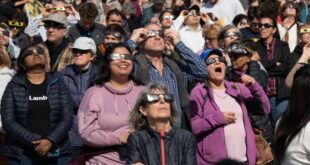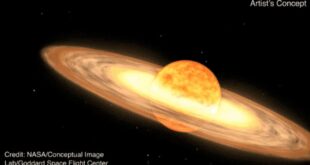Sediments from Ontario’s Crawford Lake picked as ‘golden spike’ showing global human impact on Earth.

This Ontario lake could help scientists define our next geological era
A group of scientists is pushing to have a new geological epoch declared, something that only happens every few million years, or longer. Named the ‘Anthropocene,’ they say it is driven by human activity.
Scientists have picked the bottom of Crawford Lake in Ontario as the “golden spike” to mark the start of a new proposed geological epoch — the Anthropocene. The announcement was made at a media conference in Berlin Tuesday by a group of scientists called the Anthropocene Working Group — more on them later.
Here’s why the lake was chosen and what evidence it provides that humans have made such big changes to the Earth that we may be in a new geologic time period.

What’s an epoch? And why are scientists proposing a new one called the Anthropocene?
Geologists measure the history of the Earth using the geologic time scale (its official name is the International Chronostratigraphic Chart) — kind of like a calendar, except that it’s divided into much bigger divisions than days, weeks or months.
For example, “periods” like the Jurassic and Cretaceous are tens of millions of years long and divided into epochs that are typically millions of years long.
Until now, our current epoch has been the Holocene, which started at the end of the last ice age 11,700 years ago.
But in many fields, including science, researchers and thinkers had already been discussing the huge impact humans have had on the Earth — including mass extinction and climate change, the kind of changes that typically mark the start and end of epochs.
About two decades ago, Nobel prizing winning chemist Paul Crutzen popularized the idea that science should recognize that impact with a new geological epoch, the Anthropocene, Prof. Jürgen Renn,director at the Max Planck Institute for the History of Science in Berlin, said at a news briefing about the new announcement.
“He said, ‘You know, we cannot say with all these changes that we are living still in the Holocene,'” Renn said. “It’s not just about climate change. It’s not just biodiversity loss. It’s not just the sediments that humans are moving. It’s all of this together.”

Half of world’s species in decline, study suggests
A new study suggests half of the world’s species are in decline, amounting to what it warns is the widespread erosion of global biodiversity and another signal the planet is entering a mass extinction.
He added that much of the ongoing change is effectively irreversible, such as the melting of glaciers around the world: “These changes that we have induced already will only unfold in the next decades and centuries.”
That said, the proposal that we’re in a new epoch has been controversial.
So where does Crawford Lake come in?
The International Commission on Stratigraphy, a group of geologists within the International Union of Geological Sciences, is the scientific body that officially decides when epochs begin and end. In 2009, it asked a group of geologists, paleontologists and other scientists, the Anthropocene Working Group, to look into whether there was enough scientific evidence to back up Crutzen’s proposal of a new epoch.
One of the group’s key jobs has been to identify and describe a “golden spike” marking the start of the new proposed epoch.
Crawford Lake was chosen among 12 “golden spike” candidates around the world after a series of votes by the Anthropocene Working Group.

What exactly is a ‘golden spike?’
A “golden spike” is the ideal marker showing where one epoch ends and another begins — typically at a major global event such as a mass extinction or climatic shift. Such events are generally visible in the form of layered evidence like changing fossils in rock deposited over time.

As you might guess, “golden spike” is actually a nickname for a more technical scientific term: global boundary stratotype section and point (GSSP).
Thesection is the series of layers (also called “strata”, which is what makes it a “stratotype” section) where there’s physical evidence of the big event (the point) that marks the end of one epoch and the start of the next.
It’s chosen as a reference that can be used to compare evidence of that event in other parts of the world.
Where is Crawford Lake and what’s so special about it?
Crawford Lake is a relatively small lake about 60 kilometres west of Toronto. The lake is inside a conservation area that shares its name outside the town of Milton. It’s on the Niagara Escarpment, which is made of limestone rock. The rock forms a bowl that holds the lake.
The park has hiking trails, as well as a reconstructed 15th-century longhouse village. Archaeological excavations show several hundred Attawonderon or Wendat people lived near the lakeshore from the 13th to 15th centuries.

The lake itself is less than 300 metres across at its widest point, but very deep for its size — 24 metres, meaning a seven- or eight-storey building sitting on the lake bottom would just barely break the surface.
Because of that, Crawford Lake is meromictic — that is, it’s a rare type of lake where the bottom layer of water doesn’t mix with upper layers.
Francine McCarthy, an earth sciences professor at Brock University in St. Catharines, Ont., who has been studying the lake, said that means the bottom of the lake is “completely isolated from the rest of the planet, except for what gently sinks to the bottom and accumulates in sediment.”
There is also some handy chemistry happening in the water. Remember how it’s surrounded by limestone? The rock contains calcium and carbonate that dissolve in the water, but crystallize out in the surface waters when it gets warm — how much depends on that year’s climate. The crystals fall down as white layers that mark each summer like tree rings, covering the pollen, dead microorganisms, pollution particles and other debris that accumulate the rest of the year.
Together they provide a record of the climate, environmental and ecological conditions each year. Because the shores of Crawford Lake were inhabited by humans hundreds of years ago, it also allowed scientists to compare human impacts then and now.
McCarthy and her team have drilled cylinders called sediment cores out of the bottom of the lake that preserve the annual layers so that they can be examined and tested in the lab.

What’s the global event that’s been proposed to mark the start of the Anthropocene?
Originally, Crutzen had proposed the Industrial Revolution of the 19th century as the start of the Anthropocene.
But it turns out scientific evidence of the Industrial Revolution from that time is mostly only seen in Europe and not other parts of the world, said Colin Waters, honorary professor of geography, geology and the environment at the University of Leicester in the U.K. and chair of the Anthropocene Working Group.
Because of that, scientists began proposing that the start of the Anthropocene should be marked by evidence of nuclear weapons tests in the 1950s, such as radioactive plutonium, which is detectable worldwide.
“It’s a very clear marker,” Waters said.
But it also coincides with increased burning of fossil fuels, use of industrial fertilizers and other human impacts that leave a clear scientific signal — together called “The Great Acceleration” by environmental historian John McNeill.
And so radioactive plutonium has been chosen as the marker for the start of the Anthropocene in the Crawford Lake sediment core.

Why is the Anthropocene epoch controversial?
Members of the Anthropocene Working Group themselves acknowledge that this isn’t a typical geological division.
Typically, layers of rock and often fossils are used as markers between different periods of time, but in this case, rock hasn’t had time to be deposited.
Renn said the “geology of the present” is a new challenge. “That’s very, very unusual.”
It’s not only that rocks haven’t had time to form, but also the materials and signals being measured and referenced, such as plutonium and microplastics, are very new and different from those of the past.

But some researchers argue it’s just too soon to call this a new epoch.
John-Paul Zonneveld, a professor at the University of Alberta and a member of the North American Commission on Stratigraphic Nomenclature, acknowledged that humans have made big changes and left their permanent mark all over the Earth, but he said he feels “we’re in the middle of the event. We’re not in the new time stage yet.”
Joseph Deloges, a professor of geography and earth sciences at the University of Toronto who hasn’t been involved with the Anthropocene Working Group, has a similar perspective, and says it’s a challenge.
“Whatever you try and define in terms of the Anthropocene means it’s changing as you go along. And so some would argue that’s not what the nomenclature is set up for,” he said.
He added that while climate change has been quite dramatic, it may not yet match the scale events like asteroid impacts that have ushered in some other new time periods on the geologic timescale: “Some would argue we’re not quite there yet in terms of the catastrophe.”

What the ‘doomsday glacier’ can teach us about the fate of Earth
The Thwaites glacier is an Antarctic glacier that spans roughly 120 kilometres. Climate scientist David Holland talks to The National co-host Ian Hanomansing about what Thwaites — sometimes called the ‘doomsday glacier’ — can tell us about the fate of the planet.
The Anthropocene is still just a proposal. What needs to happen for it to become an actual epoch?
The Anthropocene Working Group still needs to come up with an “auxiliary” GSSP out of eight other sites. Then the proposal needs to pass three more votes with a “supermajority” of more than 60 per cent, including one at the International Commission on Stratigraphy and a final one from the International Union of Geological Sciences.
“It’s a very conservative process, you know,” said Waters, “and probably there’s good reason for that because you don’t want to establish the formalization of the unit if it’s not grounded on very strong evidence.”
He added that it’s also possible that the geological community will decide that the Anthropocene is simply a new stage within the Holocene epoch (after the Meghalayan, which started 4,200 years ago), and not a new epoch in itself.
In any case, the Anthropocene Working Group hopes a decision will be made in time for the International Geological Congress in Busan, Korea, in August 2024.
ABOUT THE AUTHOR

Science, climate, environment reporter
Emily Chung covers science, the environment and climate for CBC News. She has previously worked as a digital journalist for CBC Ottawa and as an occasional producer at CBC’s Quirks & Quarks. She has a PhD in chemistry from the University of British Columbia. In 2019, she was part of the team that won a Digital Publishing Award for best newsletter for “What on Earth.” You can email story ideas to Emily.Chung@cbc.ca.
With files from Rukhsar Ali
*****
Credit belongs to : www.cbc.ca
 Atin Ito First Filipino Community Newspaper in Ontario
Atin Ito First Filipino Community Newspaper in Ontario






